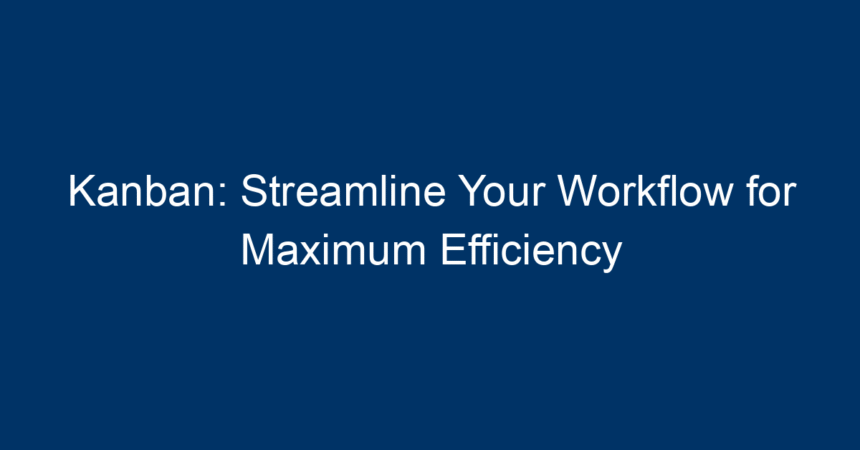In today’s fast-paced business environment, efficiency is key. Organizations are continually looking for methodologies that can help them manage their workflows better. One such approach that has gained tremendous popularity over the years is Kanban. Originating from Japan, Kanban is not just a tool but a philosophy that fosters continuous improvement and visualizes work, making it ideal for teams eager to optimize their processes. In this article, we’ll explore the essentials of Kanban, its principles, and how you can implement it to achieve maximum efficiency in your workflow.
What is Kanban?
Kanban, which translates to "visual signal" in Japanese, is a workflow management method designed to visualize work, limit work-in-progress (WIP), and maximize efficiency. Initially developed for the Toyota Production System to improve manufacturing processes, Kanban has since evolved to be applicable in various fields such as software development, operations, and even personal productivity.
The Core Components of Kanban
Understanding the core components of Kanban is essential for effective implementation. The three main elements include:
-
Visual Management: At its heart, Kanban relies heavily on visual signals. This typically involves a Kanban board, which can be physical (sticky notes on a whiteboard) or digital (Kanban software). The primary purpose of the board is to offer a clear overview of tasks within the workflow.
-
Work-in-Progress Limits (WIP): To ensure teams focus on completing tasks rather than starting too many at once, Kanban advocates setting limits on how many tasks can be in progress at any one time. This creates a more manageable workload and helps prevent bottlenecks.
- Continuous Improvement: Kanban encourages teams to consistently evaluate and improve their processes. Regular retrospectives and reflection sessions allow teams to identify what works, what doesn’t, and how they can evolve over time.
Benefits of Using Kanban
Implementing Kanban can yield a multitude of benefits for your organization. Let’s delve into some of the most significant advantages.
Enhanced Visualization of Work
One of the standout features of Kanban is its ability to provide a clear visual representation of the workflow. This visualization aids in task prioritization and allows teams to see the status of various tasks in real time. For instance, when using a Kanban board, any team member can quickly determine what tasks are pending, in progress, or completed.
Improved Collaboration and Communication
When teams utilize Kanban, it fosters better collaboration. Team members can easily see who is working on what and can communicate effectively to avoid duplication of efforts. The visual nature of Kanban boards promotes transparency, which ultimately enhances interpersonal relationships within the team.
Increased Flexibility
Unlike traditional project management methodologies that require detailed planning upfront, Kanban allows for greater flexibility. Teams can quickly adapt to changes, whether they arise from shifting priorities or new information. This agility ensures that projects stay on track and that teams can pivot as necessary.
Reduced Cycle Times
By limiting work in progress and focusing on completing tasks before taking on new ones, Kanban can significantly reduce cycle times. This means that tasks get completed faster, leading to increased overall productivity.
Focus on Quality
With Kanban, teams are encouraged to maintain quality over quantity. By focusing on fewer tasks at a time and promoting continuous improvement, teams become more adept at identifying issues and rectifying them, thus enhancing the quality of their outputs.
Implementing Kanban: A Step-by-Step Guide
Are you ready to implement Kanban in your organization? Here’s a step-by-step guide to get you started.
Step 1: Assess Your Current Workflow
Before you implement Kanban, assess your current workflow. Identify tasks, bottlenecks, and areas where processes can be improved. Understanding your starting point will help you make informed decisions moving forward.
Step 2: Set Up Your Kanban Board
Whether you opt for a physical board or a digital platform like Trello, Jira, or Asana, the setup process involves defining columns representing different workflow stages (e.g., To Do, In Progress, Done). Make sure to include WIP limits for each stage to maintain efficiency.
Step 3: Define Your Tasks
Break down larger projects into manageable tasks. Use concise task descriptions to make it easier for team members to understand what needs to be done.
Step 4: Start Using Your Kanban Board
Begin adding tasks to the board, moving them through various stages of completion. Encourage your team to update the board regularly to ensure accurate representation.
Step 5: Monitor and Adapt
Regularly review your Kanban system. Hold retrospectives to evaluate what’s working and what can be improved. Adapt your processes based on team feedback and performance metrics.
Key Principles of Kanban
To use Kanban effectively, it’s crucial to understand its key principles:
-
Visualize the Workflow: Create a Kanban board that visualizes the full workflow. This clarity helps in understanding the current workload and makes it easier to identify bottlenecks.
-
Limit Work in Progress: Set specific limits on how many tasks can be in progress at once. This will help reduce the feeling of overwhelm and improve focus.
-
Manage Flow: Analyze and manage your workflow consistently to ensure tasks move smoothly through each stage. If tasks are getting stuck, investigate why and make appropriate adjustments.
-
Make Process Policies Explicit: Clearly define the policies and procedures your team will follow. Having explicit guidelines helps in maintaining consistency across the board.
- Implement Feedback Loops: Use retrospectives and regular check-ins to gather feedback and continuously improve processes.
Best Practices for Kanban Success
Here are some best practices to ensure your Kanban system runs smoothly:
-
Keep It Simple: Start with a basic Kanban board. As your team becomes more comfortable, you can build on it with additional features.
-
Ensure Clear Communication: Promote open communication within the team, allowing members to discuss any challenges they face.
-
Focus on Continuous Improvement: Regularly review processes at team meetings and discuss how visual signals and WIP limits can be adjusted for better outcomes.
-
Tailor Kanban to Your Needs: Adapt the Kanban system to fit your team’s specific needs rather than sticking to a rigid structure.
- Use Technology to Your Advantage: Explore various Kanban tools that offer features such as task assignments, timelines, and reporting to streamline your process even further.
Conclusion: Harness the Power of Kanban for Optimal Workflow Management
Kanban offers an invaluable way to streamline your workflow, enhance your team’s efficiency, and drive continuous improvement. By visualizing tasks, limiting work in progress, and fostering collaboration, organizations can achieve remarkable gains in productivity and quality.
To successfully implement Kanban, begin by assessing your current workflow, set up a Kanban board, define tasks clearly, and continuously monitor and adapt your approach. As you cultivate a culture of transparency and improvement, you’ll find that both your team and your projects thrive.
Now that you have a comprehensive understanding of what Kanban is and how it can transform your work processes, why not take the first step toward maximum efficiency today? Embrace the Kanban philosophy and watch your productivity soar!




